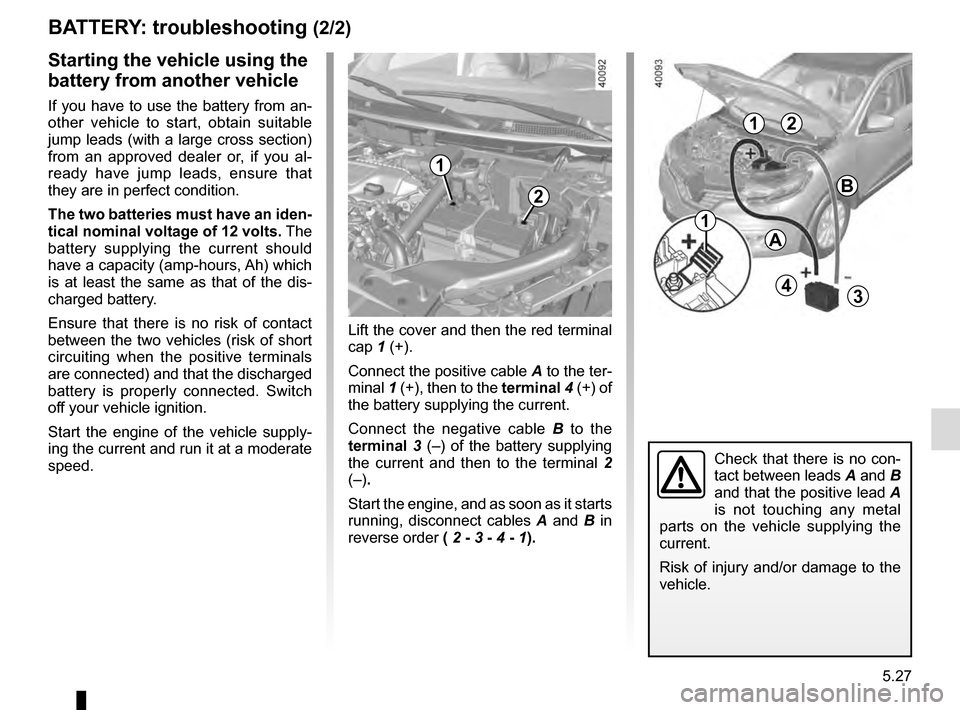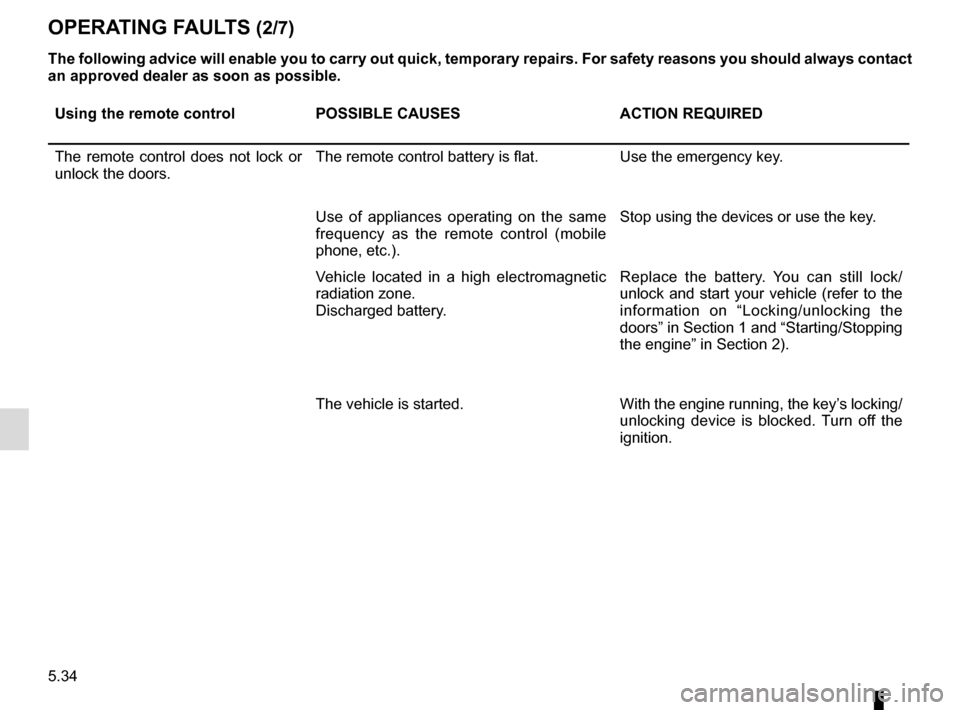2016 RENAULT KADJAR ignition
[x] Cancel search: ignitionPage 261 of 300

5.27
Starting the vehicle using the
battery from another vehicle
If you have to use the battery from an-
other vehicle to start, obtain suitable
jump leads (with a large cross section)
from an approved dealer or, if you al-
ready have jump leads, ensure that
they are in perfect condition.
The two batteries must have an iden-
tical nominal voltage of 12 volts. The
battery supplying the current should
have a capacity (amp-hours, Ah) which
is at least the same as that of the dis-
charged battery.
Ensure that there is no risk of contact
between the two vehicles (risk of short
circuiting when the positive terminals
are connected) and that the discharged
battery is properly connected. Switch
off your vehicle ignition.
Start the engine of the vehicle supply-
ing the current and run it at a moderate
speed.
BATTERY: troubleshooting (2/2)
1
B
A
Lift the cover and then the red terminal
cap 1 (+).
Connect the positive cable A to the ter-
minal 1 (+), then to the terminal 4 (+) of
the battery supplying the current.
Connect the negative cable B to the
terminal 3 (–) of the battery supplying
the current and then to the terminal 2
(–).
Start the engine, and as soon as it starts
running, disconnect cables A and B in
reverse order ( 2 - 3 - 4 - 1).
2
43
2
Check that there is no con-
tact between leads A and B
and that the positive lead A
is not touching any metal
parts on the vehicle supplying the
current.
Risk of injury and/or damage to the
vehicle.
1
1
Page 263 of 300

5.29
WINDSCREEN WIPER BLADES: replacement (1/2)
Windscreen wiper blades 1
With the ignition on and the engine
switched off, lower the windscreen
wiper stalk fully: the blades stop slightly
away from the bonnet.
Lift wiper arm 3 , press button 2 to re-
lease the blade.
1
23
Refitting
Slide the blade along the arm until
it clips on. Check that it is correctly
locked in place. Lower the windscreen
wiper arm carefully.
With the ignition on, return the wind-
screen wiper stalk to the stop position.
The blade on the driver’s side must
always be above the passenger blade.
If this is not the case, a quick sweep of
the windscreen wipers should be per-
formed once the vehicle is travelling at
over 4 mph (7 km/h).
NB: Before restarting your vehicle,
lower the windscreen wiper blades
onto the windscreen to avoid any risk
of damaging the bonnet or the wipers.
– In frosty weather, make
sure that the wiper blades
are not stuck by ice (to
avoid the risk of the motor
overheating or damaging the
blades).
– Check the condition of the wiper
blades.
Replace the wiper blades as soon
as they begin to lose efficiency
(approximately once a year).
Whilst changing the blade, take care
not to drop the arm onto the window
after it has been removed as this
may break the window.
Do not activate the wipers on a dry
screen. This will lead to premature
wear or damage to the blades.
Page 265 of 300

5.31
TOWING: breakdown recovery (1/2)
Before towing, put the gearbox in neu-
tral, unlock the steering column and re-
lease the parking brake.
For vehicles fitted with an automa-
tic gearbox, if it is not possible to put
the gear lever into position N, please
consult an authorised dealer.
Steering column unlocking
Insert the key into the ignition or, de-
pending on the vehicle, having the
RENAULT card on you, press the
engine start button for approximately
2 seconds.
Reposition the lever to neutral (posi-
tion N for vehicles fitted with an auto-
matic gearbox).
The steering column unlocks, the ac-
cessory functions are powered: you
can use the vehicle’s lights (direction
indicators, brake lights, etc.). At night
the vehicle must have its lights on.
Depending on the vehicle, once you
have finished towing, press the engine
start button twice (risk of running down
the battery). The speed specified by current legisla-
tion for towing must always be obser-
ved. If your vehicle is the towing vehi-
cle, do not exceed the maximum towing
weight for your vehicle (refer to the in-
formation on “Weights” in Section 6).
Towing a vehicle with an
automatic gearbox
Transport the vehicle on a trailer or tow
it with the front wheels off the ground.
In exceptional circumstances
, you
may tow it with all four wheels on the
ground, only in a forward gear, with the
gear in neutral position N over a maxi-
mum distance of 50 miles and not ex-
ceeding a speed of 15 mph (25 km/h).
1
2
Do not remove the key from
the ignition when the vehi-
cle is being towed.
If the lever is stuck in P , even though
you are depressing the brake pedal, the
lever can be released manually. To do
this, insert a tool (with a hard rod to it)
into the slot 1 and press the button 2 at
the same time to unlock the lever.
Contact an authorised dealer as soon
as possible.
Page 268 of 300

5.34
The following advice will enable you to carry out quick, temporary repai\
rs. For safety reasons you should always contact
an approved dealer as soon as possible.
Using the remote controlPOSSIBLE CAUSES ACTION REQUIRED
The remote control does not lock or
unlock the doors. The remote control battery is flat.
Use the emergency key.
Use of appliances operating on the same
frequency as the remote control (mobile
phone, etc.). Stop using the devices or use the key.
Vehicle located in a high electromagnetic
radiation zone.
Discharged battery. Replace the battery. You can still lock/
unlock and start your vehicle (refer to the
information on “Locking/unlocking the
doors” in Section 1 and “Starting/Stopping
the engine” in Section 2).
The vehicle is started. With the engine running, the key’s locking/
unlocking device is blocked. Turn off the
ignition.
OPERATING FAULTS (2/7)
Page 270 of 300

5.36
OPERATING FAULTS (4/7)
On the roadPOSSIBLE CAUSESWHAT TO DO
Vibrations. Tyres not inflated to correct pres-
sures, incorrectly balanced or dam-
aged. Check the tyre pressures: if this is not the
problem, have them checked by an ap-
proved Dealer.
White smoke from the exhaust. In the diesel version, this is necessar-
ily a fault. Smoke may be caused by
particle filter regeneration. Please refer to the information on “Special
features of diesel versions” in Section 2.
Smoke under the bonnet. Short-circuit or cooling system leak. Stop, switch off the ignition, stand away
from the vehicle and contact an approved
dealer.
The oil pressure warning light comes
on: while cornering or braking The level is too low. Top up the engine oil level (refer to the in-
formation on “Engine oil level: topping up,
filling” in Section 4).
is slow to go out or remains lit
under acceleration Loss of oil pressure.
Stop the vehicle and contact an approved
Dealer.
Page 295 of 300

7.3
ALPHABETICAL INDEX (3/5)
hazard warning lights signal .............................................. 1.84
headlight beam adjustment .................................... 1.85 – 1.86
headrest................................................................\
.... 1.19, 3.24
heated seats ...................................................................... 1.20
heated windscreen ..................................................3.7 → 3.12
heating and air conditioning system ........................3.4 → 3.13
heating system ........................................................3.4 → 3.13
Hill Start Assist.......................................................2.29 → 2.38
horn ...................................................................\
................ 1.84
horn: flash ..................................................................\
........... 1.84
hubcap tool ................................................................. 5.7 – 5.8
I
ignition switch ...................................................................... 2.3
indicators ......................................................1.84, 5.14 → 5.19
indicators: direction indicators ....................................................... 1.84
instrument panel ..............................................1.54 → 1.63
instrument panel ....................................................1.54 → 1.71
instrument panel messages...................................1.62 → 1.71
interior trim maintenance ..................................................... 4.16 – 4.17
Isofix ....................................................................... 1.37 – 1.38
J
jack ...................................................................\
................... 5.7
K
keys ...................................................................\
........1.2 → 1.5
L
lane departure warning ..........................................2.43 → 2.45
levels .................................................................\
........4.7 → 4.9
levels: brake fluid ...................................................................... 4.8 coolant ................................................................\
........... 4.7
windscreen washer reservoir ......................................... 4.9
lifting the vehicle changing a wheel ................................................ 5.9 – 5.10
lighting: exterior .............................................................1.\
79 → 1.86
instrument panel .......................................................... 1.79
interior ...............................................................\
.. 3.17, 5.20
lights adjustment ........................................................ 1.85 – 1.86
changing bulbs .................................................5.14 → 5.16
front ..................................................................\
5.14 → 5.16
lights: adjusting ........................................................... 1.85 – 1.86
brake lights ......................................................5.17 → 5.19
dipped beam headlights .................1.54, 1.79, 5.14 → 5.16
direction indicators .........................1.54, 1.84, 5.14 → 5.17
fog lights .................................................... 1.54, 1.81, 5.19
hazard warning ............................................................ 1.84
main beam headlights ................................ 1.54, 1.79, 5.14
reversing lights ............................................................. 5.19
side lights ................................................1.79, 5.14 → 5.17
load permitted on the roof..............................................\
...... 6.6
locking the doors ..............................................1.4, 1.6 → 1.18
luggage compartment cover .............................................. 3.28
luggage retaining net .............................................. 3.33 – 3.34
M
maintenance ............................................................\
.......... 2.24
maintenance: bodywork .......................................................... 4.14 – 4.15
interior trim ........................................................ 4.16 – 4.17
mechanical ..............................4.4, 4.12 – 4.13, 6.8 → 6.13
map reading lights ............................................................. 3.17
menu for customising the vehicle settings .............. 1.72 – 1.73
methods of restraint in addition to the seat belts ...1.27 → 1.33
Page 296 of 300

7.4
ALPHABETICAL INDEX (4/5)
mobile floor ........................................................................\
3.29
multimedia equipment ....................................................... 3.37
N
navigation system .............................................................. 3.37
O
oil change ................................................................... 4.5 – 4.6
opening the doors ..................................................1.13 → 1.17
operating faults ................................ 1.54 → 1.59, 5.33 → 5.39
overspeed warning ................................................2.53 → 2.55
P
paintwork maintenance ..................................................... 4.14 – 4.15
parking assistance: assisted parking .....................2.67 → 2.70
parking distance control.........................................2.60 → 2.64
power-assisted steering.................................................\
.... 1.74
pretensioners .........................................................1\
.27 → 1.30
puncture............................................. 5.2 – 5.3, 5.7, 5.9 – 5.10
R
radio...................................................................\
................ 3.37
radio frequency remote control/key use ....................................................................\
...1.2 → 1.4
rear bench seat....................................................... 3.25 – 3.26
rear parcel shelf ................................................................. 3.28
rear seats..............................................................\
............. 1.25 functions ........................................................... 3.25 – 3.26
rear view mirrors ....................................................1.76 → 1.78
remote control door locking batteries ..............................................................\
......... 5.22
remote control door locking unit ................................1.2 → 1.4
RENAULT ANTI-INTRUDER DEVICE (RAID) ................... 1.18
RENAULT card battery ................................................................\
.......... 5.21 use ................................................... 1.6
→ 1.12, 2.5 → 2.7
RENAULT card battery ...................................................... 5.21
replacement parts ................................................................ 6.7
reverse gear selecting ..................................................2.14, 2.71 → 2.73
reversing sensor ....................................................2.60 → 2.64
roof bars ................................................................. 3.35 – 3.36
roof rack roof bars ............................................................ 3.35 – 3.36
running in .................................................................... 2.2 – 2.3
S
seat belt pretensioners front seat belt ...................................................1.27 → 1.30
seat belts ......................................................1.23 → 1.30, 1.33
service sheets..........................................................\
6.8 → 6.13
side protection devices ...................................................... 1.32
sign detection: overspeed warning ........................2.53 → 2.55
signals and lights ...................................................1.79 → 1.86
special features of diesel versions.....................................\
2.13
special features of petrol vehicles ..................................... 2.12
speed limiter .................................................1.57, 2.50 → 2.52
spoiler ................................................................\
................ 3.36
starting the engine ................................................... 2.3 → 2.11
steering wheel adjustment .............................................................\
...... 1.74
Stop & Start .................................................... 1.57, 2.8 → 2.11
Stop & Start function................................................ 2.8 → 2.11
stopping the engine ...................................................2.4 → 2.7
storage compartment.............................................3.18 → 3.22
storage compartments ...........................................3.18 →
3.22
sun visor ........................................................................\
.... 3.18
switching on the vehicle ignition .........................2.3, 2.5 →
2.7
T
tailgate ..........................................................3.27,\
3.29 → 3.31